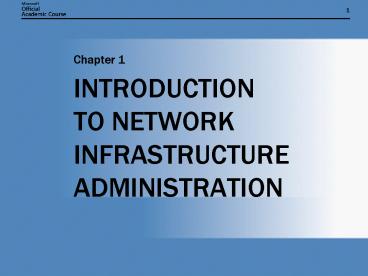INTRODUCTION TO NETWORK INFRASTRUCTURE ADMINISTRATION - PowerPoint PPT Presentation
1 / 32
Title:
INTRODUCTION TO NETWORK INFRASTRUCTURE ADMINISTRATION
Description:
Has maximum speed of 16 Mbps. Uses token passing media access control mechanism ... Allows higher speed media like fiber optic to be implemented on high demand ... – PowerPoint PPT presentation
Number of Views:129
Avg rating:3.0/5.0
Title: INTRODUCTION TO NETWORK INFRASTRUCTURE ADMINISTRATION
1
INTRODUCTION TO NETWORK INFRASTRUCTURE
ADMINISTRATION
- Chapter 1
2
CHAPTER INTRODUCTION
- Describe the network infrastructure design
process. - Understand the security ramifications of network
design decisions. - List the tasks involved in maintaining a network
infrastructure. - Select the appropriate data-link and
network/transport layer protocols for a given
environment. - Plan locations for workstations, peripherals,
cables, connectivity devices, and servers on your
network.
3
NETWORK INFRASTRUCTURE DESIGN OVERVIEW
- Select the hardware and software components that
will make up the network infrastructure. - Determine the specific location for each
component. - Specify how each component will be installed and
configured.
4
NETWORK DESIGN COMPONENTS
- Physical infrastructure
- Logical infrastructure
5
PHYSICAL INFRASTRUCTURE
- Topology
- Cabling
- Network devices (routers, hubs, switches)
6
LOGICAL INFRASTRUCTURE
- Software elements including
- Network communication protocols
- Security protocols
- Network routing protocols
7
DETERMINING NETWORK REQUIREMENTS
- Evaluating user requirements
- Designing security
8
IMPLEMENTING A NETWORK INFRASTRUCTURE
- Installation of physical components
- Deployment of server operating systems
- Configuration of services
9
NETWORK INFRASTRUCTURE SECURITY OVERVIEW
- Estimating security risks
- Specifying security requirements
- Selecting security features
- Implementing security policies
- Designing security deployments
- Specifying security management policies
10
DETERMINING SECURITY REQUIREMENTS
- Determine responsibilities for designing,
implementing, and maintaining the security
policies. - Assign responsibilities to technical and
management staff. - Consider economic issues and the effect of
security policies on employee productivity and
morale.
11
MAPPING OUT A SECURITY LIFE CYCLE
- Designing a security infrastructure
- Implementing security features
- Maintaining security management
12
NETWORK INFRASTRUCTURE MAINTENANCE OVERVIEW
- Deploying software updates
- Monitoring network performance
- Troubleshooting network problems
13
SELECTING PROTOCOLS
- What is a protocol?
14
UNDERSTANDING THE OSI REFERENCE MODEL
15
SELECTING DATA-LINK LAYER PROTOCOLS
- The data-link layer protocol defines
- Physical layer implementation
- Media access method
- Speed of the network
16
SELECTING A MEDIA TYPE
- Unshielded twisted pair (UTP)
- Fiber optic
- Wireless networking
17
CHOOSING AN ETHERNET VARIANT
- Standard Ethernet10 Mbps
- UTP
- Fast Ethernet100 Mbps
- UTP, fiber optic
- Gigabit Ethernet1000 Mbps
- UTP, fiber optic
18
USING TOKEN RING
- Has maximum speed of 16 Mbps
- Uses token passing media access control mechanism
- Uses connectivity devices called multistation
access units (MAU)
19
MIXING MEDIA
- Means routers and switches can accommodate more
than one media type - Allows higher speed media like fiber optic to be
implemented on high demand network segments such
as backbones - Enables the most appropriate media to be used for
a specific purpose
20
SELECTING NETWORK/TRANSPORT LAYER PROTOCOLS
- Transmission Control Protocol/Internet Protocol
(TCP/IP) - Internetwork Packet Exchange (IPX)
- NetBIOS Extended User Interface (NetBEUI)
21
USING TCP/IP
- Protocol used on the Internet
- Almost universal support
- Complex addressing
22
USING IPX
- Proprietary technology
- Routable
- Implemented as NWLink on Windows networks
23
USING NETBEUI
- Designed for small networks
- Not routable
- Proprietary
24
LOCATING PHYSICAL RESOURCES
- Workstations
- Peripherals
- Cables
- Connectivity devices
- Servers
25
DETERMINING LOCATION CRITERIA
- Access for users
- Access for technical staff
- Security of devices and data
- Environmental considerations (noise, heat, etc.)
26
LOCATING WORKSTATIONS
- Where are users located?
- What kind of computers do they use?
27
LOCATING PERIPHERALS
- Printers
- Scanners
28
LOCATING CABLES
- Internal inside walls, ceiling spaces, risers
- External along walls or door frames
29
LOCATING CONNECTIVITY DEVICES
- Hubs, switches, patch panels, routers
- Network constraints
- Security
- Noise
30
LOCATING SERVERS
- Proximity to users
- Security
- Controlled environment
31
CHAPTER SUMMARY
- A network infrastructure is a set of components
that provides connectivity, security, management,
access, and other integral features on a network.
- Maintaining a network infrastructure includes
deploying software updates, monitoring network
performance, and troubleshooting problems. - Selecting a data-link layer protocol is primarily
a matter of choosing an appropriate network
medium and transmission speed.
32
CHAPTER SUMMARY (CONT.)
- TCP/IP is the industry standard protocol suite at
the network and transport layers. Windows Server
2003 also supports NWLink IPX/SPX compatible
transport and NetBEUI. - Determining the appropriate location for network
components is a critical part of the network
infrastructure planning process.































